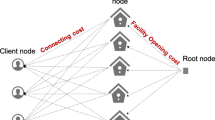Abstract
The problem of locating flow-intercepting facilities on a network with probabilistic customer flows and with facility set-up costs is studied in this paper. Two types of models are investigated, namely the double-counting model and the no-double-counting model (double-counting refers to multiple interceptions of the same customer). For each model, a nonlinear integer programming formulation is first obtained via the theory of Markov chains, and an equivalent linear integer program is then derived. A simple greedy heuristic is proposed for solving both models and a worst-case bound is established, which is shown to be tight under certain conditions.
Similar content being viewed by others
References
O. Berman, The maximizing market size with congestion, Socio-Economic Planning Sciences 29(1995)39–46.
O. Berman, D. Bertsemas and R.C. Larson, Locating discretionary service facilities II: Maximizing market size, minimizing inconvenience, accepted by Operations Research.
O. Berman, R.C. Larson and N. Fouska, Optimal location of discretionary service facilities, Transportation Science 26(23) (1992) 201–211.
O. Berman, D. Krass and C.W. Xu, Locating discretionary service facilities based on probabilistic customer flows, Transportation Science 29(1995)276–290.
O. Berman, D. Krass and C.W. Xu, Generalized discretionary service facility location models with probabilistic customer flows, Working Paper (1994), revised for Stochastic Models.
E. Çinlar,Introduction to Stochastic Processes (Prentice-Hall, NJ (1974).
G. Cornuéjols, M.L. Fisher and G.L. Nemhauser, Locations of bank accounts to optimize float: An analytic study of exact and approximate algorithms, Management Science 23(1977)789–809.
R.B. Dial, A probabilistic multi path traffic assignment model which obviates path enumeration, Transportation Research 5(1971)83–111.
J. Hodgson, A flow-capturing location-allocation model, Geographic Analysis 22(3) (1990)270–279.
L.C.M. Kallenberg,Linear Programming and Finite Markovian Control Problems, Math. Centre Tracks 148(1983).
R.S. Lewis and T.W. Leznick, A report on Boeing fleet location and information reporting system, The Boeing Company, Wichita, Kansas, presented at the10th Annual Carnaham Crime Countermeasures Conference, University of Kentucky, Lexington, KY (1976).
G.L. Nemhauser and L.A. Wolsey,Integer and Combinatorial Optimization (Wiley, New York, 1988).
G.L. Nemhauser, L.A. Wolsey and M.L. Fisher, An analysis of the approximations for maximizing submodular set functions, Mathematical Programming 14(1978)265–294.
Y. Sheffi,Urban Transportation Networks (Prentice Hall, 1985).
Author information
Authors and Affiliations
Additional information
This work is in part supported by the NSERC grants of O. Berman and D. Krass.
Rights and permissions
About this article
Cite this article
Berman, O., Krass, D. & Xu, C.W. Locating flow-intercepting facilities: New approaches and results. Ann Oper Res 60, 121–143 (1995). https://doi.org/10.1007/BF02031943
Issue Date:
DOI: https://doi.org/10.1007/BF02031943




